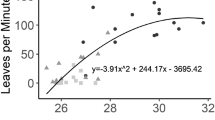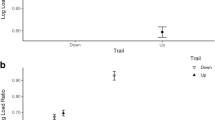Abstract
Understanding how environmental factors modulate foraging is key to recognizing the adaptive value of animal behavior, especially in ectothermic organisms such as ants. We experimentally analyzed the effect of rain on the foraging of leaf-cutting ants, a key ant group that is commonly found in rainy habitats. Specifically, we experimentally discriminate among direct and indirect effects of rain on laden ants and explore whether ants respond to rain predictors by incrementing their speed. Watered loads were frequently dropped although ants were not wet, and watered ants also dropped their loads although loads were not wet. Watered leaf fragments increased their weight by 143% and were dropped independently with regards to area or symmetry. Watering the trail did not affect the proportion of ants that dropped their loads. Ants increased their speed by 30% after experimental increments in relative humidity and the noise of raindrops on leaves near the trail. Our experimental results confirm earlier anecdotic evidence of the negative effect of rainfall on the foraging of leaf-cutting ants. We demonstrate that rain can strongly limit ant foraging through different mechanisms, affecting both the ant itself, and the maneuverability of laden ants, by increasing the weight of their loads. We also depict behavioral responses that may mitigate this negative effect on foraging: walking faster at signals of rainfall to reduce the portion of leaf fragments lost. Our results illustrate how environmental factors can directly and indirectly constrain ant foraging and highlight the relevance of behavioral responses to mitigate these effects.



Similar content being viewed by others
References
Alma A, Farji-Brener AG, Elizalde L (2016) Gone with the wind: short and long-term responses of leafcutter ants to the negative effect of wind. Behav Ecol 27:1017–1024
Bollazzi M, Roces F (2011) Information needs at the beginning of foraging: grass-cutting ants trade off load size for a faster return to the nest. PLoS One 6:e17667
Branstetter MG, Ješovnik A, Sosa-Calvo J, Lloyd MW, Faircloth BC, Brady SG, Schultz T (2017) Dry habitats were crucibles of domestication in the evolution of agriculture in ants. Proc R Soc B 284(1852):20170095
Bujan J, Yanoviak SP, Kaspari M (2016) Desiccation resistance in tropical insects: causes and mechanisms underlying variability in a Panama ant community. Ecol Evol 6:6282–6291
Burd M, Howard JJ (2005) Global optimization from suboptimal parts: foraging sensu lato by leaf-cutting ants. Behav Ecol Sociobiol 59:234–242
Califano D, Chaves-Campos J (2011) Effect of trail pheromones and weather on the moving behavior of the army ant Eciton burchellii. Insectes Sociaux 58:309–315
Chown SL, Nicolson S (2004) Insect physiological ecology: mechanisms and patterns. Oxford University Press, Oxford
Esch C, Jimenez JP, Peretz C, Uno H, O’Donnell S (2017) Thermal tolerances differ between diurnal and nocturnal foragers in the ant Ectatomma ruidum. Insectes Sociaux. https://doi.org/10.1007/s00040-017-0555-x (online first)
Farji-Brener AG, Elizalde L, Fernandez-Marín H, Amador-Vargas S (2016) Social life and sanitary risks: evolutionary and current ecological conditions determine waste management in leaf-cutting ants. Proc R Soc Ser B 283:20160625
Farji-Brener AG, Chinchilla F, Umaña M, Ocasio- Torres M, Chauta-Mellizo A, Acosta-Rojas D, Marinaro S, de Torres Curth M, Amador-Vargas S (2015) Branching angles reflect a tradeoff between reducing trail maintenance costs or travel distances in leaf-cutting ants. Ecology 96:510–517
Farji-Brener AG, Chinchilla F, Rikkin S, Sánchez-Cuervo AM, Triana E, Quiroga V, Giraldo P (2011) The “truck-driver” effect in leaf-cutting ants: how individual load influences the walking speed of nest-mates. Physiol Entomol 36:128–134
Farji Brener AG, Ruggiero A (1994). Leaf-cutting ants (Atta and Acromyrmex) inhabiting Argentina: patterns in species richness and geographical ranges sizes. J Biogeogr 21:535–543
Hart AG, Anderson C, Ratnieks FL (2002) Task partitioning in leafcutting ants. Acta Ethol 5:1–11
Hodgson ES (1955) An ecological study of the behavior of the leaf-cutting ant Atta cephalotes. Ecology 36:293–304
Hölldobler B, Wilson EO (2011) The leafcutter ants: civilization by instinct. W. W. Norton, New York
Jaffe K, Howse PE (1979) The mass recruitment system of the leaf cutting ant, Atta cephalotes (L.). Anim Behav 27:930–939
Krebs JR, Davies NB, Parr J (1993) An introduction to behavioral ecology. Blackwell Scientific Publications, Cambridge
Lighton JR, Feener DH Jr (1989) Water-loss rate and cuticular permeability in foragers of the desert ant Pogonomyrmex rugosus. Physiol Zool 62:1232–1256
Kaspari M, Clay NA, Lucas J, Yanoviak SP, Kay A (2015) Thermal adaptation generates a diversity of thermal limits in a rainforest ant community. Glob Change Biol 21:1092–1102
Lighton JR, Bartholomew GA, Feener DH (1987) Energetics of locomotion and load carriage and a model of the energy cost of foraging in the leaf-cutting ant Atta colombica Guer. Physiol Zool 60:524–537
McDade LM, Bawa KS, Hespenheide HA, Hartshorn GS (eds) (1994) La Selva: ecology and natural history of a Neotropical rain forest. University of Chicago Press, Chicago
Moll K, Roces F, Federle W (2010) Foraging grass-cutting ants (Atta vollenweideri) maintain stability by balancing their loads with controlled head movements. J Comp Physiol A 196:471–480
Moll K, Roces F, Federle W (2013). How load-carrying ants avoid falling over: mechanical stability during foraging in Atta vollenweideri grass-cutting ants. PLoS One 8(1):e52816
Mueller UG, Mikheyev AS, Hong E, Sen R, Warren DL, Solomon SE, Juenger TE. (2011) Evolution of cold-tolerant fungal symbionts permits winter fungiculture by leafcutter ants at the northern frontier of a tropical ant–fungus symbiosis. Proc Natl Acad Sci 108:4053–4056
Porter SD, Tschinkel WR (1987) Foraging in Solenopsis invicta (Hymenoptera: Formicidae): effects of weather and season. Environ Entomol 16:802–808
Riley RG, Silverstein RM, Carroll B, Carroll R (1974) Methyl 4-methylpyrrole-2-carboxylate: a volatile trail pheromone from the leaf-cutting ant, Atta cephalotes. J Insect Physiol 20:651–654
Roces F, Kleineidam C (2000) Humidity preference for fungus culturing by workers of the leaf-cutting ant Atta sexdens rubropilosa. Insectes Soc 47:348–350
Roces F, Tautz J (2001) Ants are deaf. J Acoust Soc Am 109:3080–3082
Röschard J, Roces F (2002) The effect of load length, width and mass on transport rate in the grass-cutting ant Atta vollenweideri. Oecologia 131:319–324
Spicer ME, Stark AY, Adams BJ, Kneale R, Kaspari M, Yanoviak SP (2017) Thermal constraints on foraging of tropical canopy ants. Oecologia 183:1007–1017
Weber NA (1972) The fungus-culturing behavior of ants. Am Zool 12:577–587
Whitford WG, Ettershank G (1975) Factors affecting foraging activity in Chihuahuan desert harvester ants. Environ Entomol 4:689–696
Willis MA, Avondet JL (2005) Odor-modulated orientation in walking male cockroaches Periplaneta americana, and the effects of odor plumes of different structure. J Exp Biol 208:721–735
Wolf H, Wehner R (2005) Desert ants compensante for navigation uncertainity. J Exp Biol 208:4223–4230
Acknowledgements
This work was partially supported by the Fondo para la Investigación Científica y Tecnológica, Argentina (FONCYT; PICT 2015-1319) and CONICET, Argentina (PIP 2014–2016, 11220130100665-CO) to AFGB. The Organization for Tropical Studies (OTS) provided logistical support. One anonymous reviewer, Martin Burd and G. Pizzarello provided helpful comments on the manuscript.
Author information
Authors and Affiliations
Corresponding author
Rights and permissions
About this article
Cite this article
Farji-Brener, A.G., Dalton, M.C., Balza, U. et al. Working in the rain? Why leaf-cutting ants stop foraging when it’s raining. Insect. Soc. 65, 233–239 (2018). https://doi.org/10.1007/s00040-018-0605-z
Received:
Revised:
Accepted:
Published:
Issue Date:
DOI: https://doi.org/10.1007/s00040-018-0605-z




